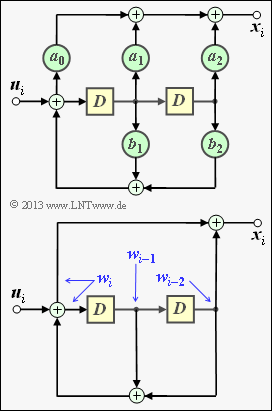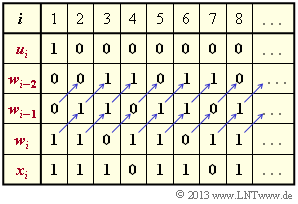Exercise 3.5: Recursive Filters for GF(2)
The upper of the two circuits on the right shows a second order recursive filter in general form. With
- $$A(D) \hspace{-0.15cm} \ = \ \hspace{-0.15cm} a_0 + a_1 \cdot D + a_2 \cdot D^2 \hspace{0.05cm},$$
- $$B(D) \hspace{-0.15cm} \ = \ \hspace{-0.15cm} 1 + b_1 \cdot D + b_2 \cdot D^2 $$
one obtains for the transfer function
- $$G(D) = \frac{A(D)}{B(D)} = \frac{a_0 + a_1 \cdot D + a_2 \cdot D^2}{1 + b_1 \cdot D + b_2 \cdot D^2} \hspace{0.05cm}.$$
- It should be noted that all arithmetic operations refer to ${\rm GF(2)}$.
- Thus, the filter coefficients $a_0, \ a_1, \ a_2, \ b_1, \ b_2$ are also binary $(0$ or $1)$.
The bottom graph shows the filter specific to the exercise at hand:
- A filter coefficient results in $a_i = 1$ if the connection is through $(0 ≤ i ≤ 2)$.
- Otherwise, $a_i = 0$. The same system applies to the coefficients $b_1$ and $b_2$.
In the subtasks (1), ... , (3) you are to determine the respective output sequence $\underline{x}$ for different input sequences
- $\underline{u} = (1, \, 0, \, 0, \, 0, \, 0, \, 0, \, 0, \, 0, \, \text{...}\hspace{0.05cm})$,
- $\underline{u} = (0, \, 1, \, 0, \, 1, \, 0, \, 0, \, 1, \, 1, \, \text{...}\hspace{0.05cm})$,
- $\underline{u} = (1, \, 1, \, 1, \, 0, \, 0, \, 0, \, 0, \, 0, \, \text{...}\hspace{0.05cm})$
using the given circuit. It should be taken into account:
- If the input sequence $\underline{u}$ consists of a "$1$" followed by all zeros, this specific output sequence $\underline{x}$ is the "impulse response" $\underline{g}$, and it holds:
- $$\underline{g} \hspace{0.15cm} \circ\!\!-\!\!\!-^{\hspace{-0.25cm}D}\!\!\!-\!\!\bullet\hspace{0.15cm}{G}(D)\hspace{0.05cm}. $$
- Otherwise, the output sequence results as the "convolution product" between the input sequence and the impulse response:
- $$\underline{x} = \underline{u} * \underline{g} \hspace{0.05cm}.$$
- The convolution operation can be bypassed with the "D-transform" .
Hints:
- This exercise belongs to the chapter "Algebraic and Polynomial Description".
- Reference is made in particular to the section "Filter structure with fractional–rational transfer function"
Solution
Solution
- The impulse response $\underline{g}$ is equal to the sequence $\underline{x}$ for the input sequence $\underline{u} = (1, \, 0, \, 0, \, \text{...})$. Based on the filter structure, $w_0 = w_{-1} = 0$ and the equations
- $$w_i \hspace{-0.2cm} \ = \ \hspace{-0.2cm} u_i + w_{i-1} + w_{i-2} \hspace{0.05cm},$$
- $$x_i \hspace{-0.2cm} \ = \ \hspace{-0.2cm} w_i + w_{i-2} $$
- the result $\underline{g} = \underline{x} = (1, \, 1, \, 1, \, 0, \, 1, \, 1, \, 0, \, 1, \, \text{...})$ corresponding to proposed solution 2, as shown in the adjacent calculation.
- But additionally the proposed solution 3 is correct, because one recognizes from this calculation scheme further following periodicities of the impulse response $\underline{g}$ (up to infinity) because of in each case same register assignment:
- $$g_3 \hspace{-0.2cm} \ = \ \hspace{-0.2cm} g_6 = g_9 = \hspace{0.05cm}\text{...} \hspace{0.05cm}= 1 \hspace{0.05cm},$$
- $$g_4 \hspace{-0.2cm} \ = \ \hspace{-0.2cm} g_7 = g_{10} =\hspace{0.05cm} \text{...} \hspace{0.05cm}= 0 \hspace{0.05cm},$$
- $$g_5 \hspace{-0.2cm} \ = \ \hspace{-0.2cm} g_8 = g_{11} =\hspace{0.05cm} \text{...} \hspace{0.05cm}= 1 \hspace{0.05cm}.$$
(2) After similar calculations as in subtask (1) one recognizes the correctness of solutions 1 and 3:
- The initial sequence $\underline{x}$ also extends to infinity.
- Periodicities show up again.
The same result is obtained by adding the impulse responses $\underline{g} = (1, \, 0, \, 1, \, 0, \, 1, \, 1, \, 0, \, 1, \, \text{...} \hspace{0.05cm})$ n the Galois field ${\rm GF(2)}$ shifted by one, three, six, and seven positions (to the right, respectively):
- $$\underline{x} = (0\hspace{0.05cm},\hspace{0.05cm} 1\hspace{0.05cm},\hspace{0.05cm} 1\hspace{0.05cm},\hspace{0.05cm} 1 \hspace{0.05cm}\hspace{0.05cm},\hspace{0.05cm} 0\hspace{0.05cm},\hspace{0.05cm}1\hspace{0.05cm},\hspace{0.05cm} 1\hspace{0.05cm},\hspace{0.05cm} 0\hspace{0.05cm},\hspace{0.05cm} \text{...}\hspace{0.05cm}) \hspace{0.05cm} + \hspace{0.05cm} (0\hspace{0.05cm},\hspace{0.05cm} 0\hspace{0.05cm},\hspace{0.05cm}0\hspace{0.05cm},\hspace{0.05cm} 1\hspace{0.05cm},\hspace{0.05cm} 1\hspace{0.05cm},\hspace{0.05cm} 1 \hspace{0.05cm}\hspace{0.05cm},\hspace{0.05cm} 0\hspace{0.05cm},\hspace{0.05cm}1\hspace{0.05cm},\hspace{0.05cm} \text{...}\hspace{0.05cm}) \hspace{0.05cm} + \hspace{0.05cm} (0\hspace{0.05cm},\hspace{0.05cm} 0\hspace{0.05cm},\hspace{0.05cm}0\hspace{0.05cm},\hspace{0.05cm} 0\hspace{0.05cm},\hspace{0.05cm} 0\hspace{0.05cm},\hspace{0.05cm} 0 \hspace{0.05cm}\hspace{0.05cm},\hspace{0.05cm} 1\hspace{0.05cm},\hspace{0.05cm}1\hspace{0.05cm},\hspace{0.05cm} \text{...}\hspace{0.05cm}) \hspace{0.05cm} + \hspace{0.05cm} (0\hspace{0.05cm},\hspace{0.05cm} 0\hspace{0.05cm},\hspace{0.05cm}0\hspace{0.05cm},\hspace{0.05cm} 0\hspace{0.05cm},\hspace{0.05cm} 0\hspace{0.05cm},\hspace{0.05cm} 0 \hspace{0.05cm}\hspace{0.05cm},\hspace{0.05cm} 0\hspace{0.05cm},\hspace{0.05cm}1\hspace{0.05cm},\hspace{0.05cm} \text{...}\hspace{0.05cm}) $$
- $$\Rightarrow \hspace{0.3cm}\underline{x} = (0\hspace{0.05cm},\hspace{0.05cm} 1\hspace{0.05cm},\hspace{0.05cm}1\hspace{0.05cm},\hspace{0.05cm} 0\hspace{0.05cm},\hspace{0.05cm} 1\hspace{0.05cm},\hspace{0.05cm} 0 \hspace{0.05cm}\hspace{0.05cm},\hspace{0.05cm} 0\hspace{0.05cm},\hspace{0.05cm}1\hspace{0.05cm},\hspace{0.05cm} \text{...}\hspace{0.05cm}) \hspace{0.05cm}. $$
Due to the linearity of the system under consideration, this is allowed.
(3) Here we choose the way over the $D$ transforms:
- $$\underline{u}= (\hspace{0.05cm}1\hspace{0.05cm},\hspace{0.05cm} 1\hspace{0.05cm},\hspace{0.05cm} 1\hspace{0.05cm}) \quad \circ\!\!-\!\!\!-^{\hspace{-0.25cm}D}\!\!\!-\!\!\bullet\quad U(D) = 1+ D + D^2 \hspace{0.05cm}.$$
- With the transfer function $G(D) = (1 + D^2)/(1 + D + D^2)$ one thus obtains for the $D$ transform of the output sequence:
- $$X(D) = {U(D)} \cdot G(D) = {1+D+D^2} \cdot \frac{1+D^2}{1+D+D^2} = 1+D^2 \hspace{0.05cm}\hspace{0.3cm} \Rightarrow \hspace{0.3cm}\underline{x} = (1\hspace{0.05cm},\hspace{0.05cm} 0\hspace{0.05cm},\hspace{0.05cm} 1\hspace{0.05cm},\hspace{0.05cm} 0 \hspace{0.05cm},\hspace{0.05cm} 0\hspace{0.05cm},\hspace{0.05cm} 0 \hspace{0.05cm}\hspace{0.05cm},\hspace{0.01cm} \text{...}\hspace{0.05cm} \hspace{0.05cm} ) \hspace{0.05cm}.$$
- Only the proposed solution 1 is correct here: despite infinitely long impulse response $\underline{g}$, for this input sequence $\underline{u}$ the output sequence $\underline{x}$ is limited to three bits.
- The same result is again obtained by adding shifted impulse responses:
- $$\underline{x} = (1\hspace{0.05cm},\hspace{0.05cm} 1\hspace{0.05cm},\hspace{0.05cm} 1\hspace{0.05cm},\hspace{0.05cm} 0 \hspace{0.05cm}\hspace{0.05cm},\hspace{0.05cm} 1\hspace{0.05cm},\hspace{0.05cm}1\hspace{0.05cm},\hspace{0.05cm} 0\hspace{0.05cm},\hspace{0.05cm} 1\hspace{0.05cm},\hspace{0.05cm} \text{...}\hspace{0.05cm}) + (0\hspace{0.05cm},\hspace{0.05cm}1\hspace{0.05cm},\hspace{0.05cm} 1\hspace{0.05cm},\hspace{0.05cm} 1\hspace{0.05cm},\hspace{0.05cm} 0 \hspace{0.05cm}\hspace{0.05cm},\hspace{0.05cm} 1\hspace{0.05cm},\hspace{0.05cm}1\hspace{0.05cm},\hspace{0.05cm} 0\hspace{0.05cm},\hspace{0.05cm} \text{...}\hspace{0.05cm}) + (0\hspace{0.05cm},\hspace{0.05cm}0\hspace{0.05cm},\hspace{0.05cm}1\hspace{0.05cm},\hspace{0.05cm} 1\hspace{0.05cm},\hspace{0.05cm} 1\hspace{0.05cm},\hspace{0.05cm} 0 \hspace{0.05cm}\hspace{0.05cm},\hspace{0.05cm} 1\hspace{0.05cm},\hspace{0.05cm}1\hspace{0.05cm},\hspace{0.05cm} \text{...}\hspace{0.05cm}) = (1\hspace{0.05cm},\hspace{0.05cm}0\hspace{0.05cm},\hspace{0.05cm}1\hspace{0.05cm},\hspace{0.05cm} 0\hspace{0.05cm},\hspace{0.05cm} 0\hspace{0.05cm},\hspace{0.05cm} 0 \hspace{0.05cm}\hspace{0.05cm},\hspace{0.05cm} 0\hspace{0.05cm},\hspace{0.05cm}0\hspace{0.05cm},\hspace{0.05cm} \text{...}\hspace{0.05cm}) \hspace{0.05cm}. $$
(4) Correct are the proposed solutions 1 and 3:
- On the data sheet, the general transfer function of a second–order recursive filter is given as follows.
- $$G(D) = \frac{a_0 + a_1 \cdot D + a_2 \cdot D^2}{1 + b_1 \cdot D + b_2 \cdot D^2} \hspace{0.05cm}.$$
- Das hier betrachtete Filter ist durch die Koeffizienten $a_0 = a_2 = b_1 = b_2 = 1$ und $a_1 = 0$ bestimmt. Somit erhält man das Ergebnis entsprechend dem Lösungsvorschlag 1:
- $$G(D) = \frac{1 + D^2}{1 + D + D^2} \hspace{0.05cm}. $$
- At the same time $G(D)$ is also the $D$ transformed of the impulse response:
- $$\underline{g}= (1\hspace{0.05cm},\hspace{0.05cm} 1\hspace{0.05cm},\hspace{0.05cm} 1\hspace{0.05cm},\hspace{0.05cm} 0 \hspace{0.05cm}\hspace{0.05cm},\hspace{0.05cm} 1\hspace{0.05cm},\hspace{0.05cm}1\hspace{0.05cm},\hspace{0.05cm}0 ,\hspace{0.05cm} \text{ ...}\hspace{0.05cm}) \hspace{0.15cm} \circ\!\!-\!\!\!-^{\hspace{-0.25cm}D}\!\!\!-\!\!\bullet\hspace{0.15cm} {G}(D)$$
- $$\Rightarrow\hspace{0.3cm} {G}(D)= 1 + D + D^2 + D^4+ D^5 +\text{...} \hspace{0.1cm}. $$
- This means: The proposed solution 3 is also correct.
- The same result would have been obtained by dividing the two polynomials $1 + D^2$ and $1 + D + D^2$, as the calculation opposite shows.



